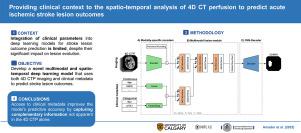Journal of Biomedical informatics ( IF 4.0 ) Pub Date : 2023-12-12 , DOI: 10.1016/j.jbi.2023.104567 Kimberly Amador 1 , Alejandro Gutierrez 1 , Anthony Winder 2 , Jens Fiehler 3 , Matthias Wilms 4 , Nils D Forkert 5

|
Acute ischemic stroke is a leading cause of mortality and morbidity worldwide. Timely identification of the extent of a stroke is crucial for effective treatment, whereas spatio-temporal (4D) Computed Tomography Perfusion (CTP) imaging is playing a critical role in this process. Recently, the first deep learning-based methods that leverage the full spatio-temporal nature of perfusion imaging for predicting stroke lesion outcomes have been proposed. However, clinical information is typically not integrated into the learning process, which may be helpful to improve the tissue outcome prediction given the known influence of various factors (i.e., physiological, demographic, and treatment factors) on lesion growth. Cross-attention, a multimodal fusion strategy, has been successfully used to combine information from multiple sources, but it has yet to be applied to stroke lesion outcome prediction. Therefore, this work aimed to develop and evaluate a novel multimodal and spatio-temporal deep learning model that utilizes cross-attention to combine information from 4D CTP and clinical metadata simultaneously to predict stroke lesion outcomes. The proposed model was evaluated using a dataset of 70 acute ischemic stroke patients, demonstrating significantly improved volume estimates (mean error = 19 ml) compared to a baseline unimodal approach (mean error = 35 ml, 0.05). The proposed model allows generating attention maps and counterfactual outcome scenarios to investigate the relevance of clinical variables in predicting stroke lesion outcomes at a patient level, helping to provide a better understanding of the model’s decision-making process.
中文翻译:

为 4D CT 灌注的时空分析提供临床背景,以预测急性缺血性中风病变结果
急性缺血性中风是全世界死亡和发病的主要原因。及时识别中风的程度对于有效治疗至关重要,而 b0>时空 (4D) 计算机断层扫描灌注 (CTP) 成像在此过程中发挥着关键作用。最近,提出了第一个基于深度学习的方法,利用灌注成像的完整时空性质来预测中风病变结果。然而,临床信息通常不会整合到学习过程中,鉴于已知的各种因素(即生理、人口和治疗因素)对病变生长的影响,这可能有助于改善组织结果预测。交叉注意力是一种多模态融合策略,已成功用于组合来自多个来源的信息,但尚未应用于中风病变结果预测。因此,这项工作旨在开发和评估一种新颖的多模式和时空深度学习模型,该模型利用交叉注意力同时结合 4D CTP 和临床元数据的信息来预测中风病变结果。使用 70 名急性缺血性中风患者的数据集对所提出的模型进行了评估,结果表明与基线单峰方法(平均误差 = 35 ml, 0.05)。所提出的模型允许生成注意力图和反事实结果场景,以研究临床变量在患者层面预测中风病变结果的相关性,有助于更好地理解模型的决策过程。











































 京公网安备 11010802027423号
京公网安备 11010802027423号